
For the thesis project in this program, we work in teams of two. We come up with a proposal together and then each focus on different aspects of how to fabricate the project to complete our individual research. All of the research projects last year studied ways that wasted materials could be utilized to make architecture.
Our proposal looked at applying recent research conducted at the University of Kyushu, where a process that turns mixed food waste into PLA, the type of plastic used in many 3D printers, was discovered.
More broadly, we looked at how to combine digital scripting and fabrication methods to create an architectural prototype that can be used to make the city of Tokyo more sociable, productive, and responsive to the needs of its inhabitants.


The project seeks to establish a link between scripted organizational patterns and digital interface systems. We have developed an architectural logic that places components in a 3-dimensional pattern and connects them utilizing a 3D extrusion tool.

The output was a prototype of the system, measuring about 1.8m X 0.8m x 0.6m, constructed by combining the digital algorithm with the tool and interface system.

The material that makes the project possible is a biodegradable thermoplastic that comes from food waste.

The material properties of the substance drive the project.
It is easy to temporarily melt the thermoplastic, which allows it to be literally drawn through the air. The temporary stickiness of this process is utilized to connect stiff, linear components.
The material performs best in tension, but has some compressive strength. This property is used to make a “springsegrity” structure that allows for inaccuracies in the construction process. This allowance for low-tolerance simplifies the assembly process.
In addition, the material can be industrially composted in five days, allowing for easy disposal of the architecture.
Finally, the translucency of the material allows for shading and visual screening.
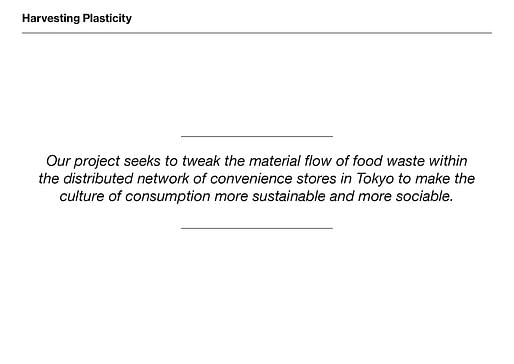
This project seeks to use this substance to change the material flow of food waste within the distributed network of convenience stores in Tokyo, to make this culture of convenience more sustainable and more social.

The culture of convenience currently forms a distributed network that has embedded itself into Japanese society as an integral part of the Everyday. The proposal takes advantage of the confluence between the distributed network of convenience stores and temporarily unused lots throughout Tokyo.
Early on in the project, we wrote a script in Processing that found all of the convenience stores in Tokyo, allowing us the map the current network.
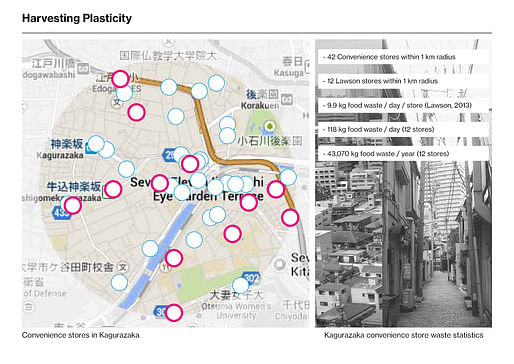
Kagurazaka, one of Tokyo’s inner residential neighborhoods, was targeted as a site for the initial architectural prototype. The district is located near the center of Tokyo, and home to a slightly older, discerning demographic. We were able to use our script, and data provided by the convenience store companies, to ascertain how much food waste is being generated in the district daily.
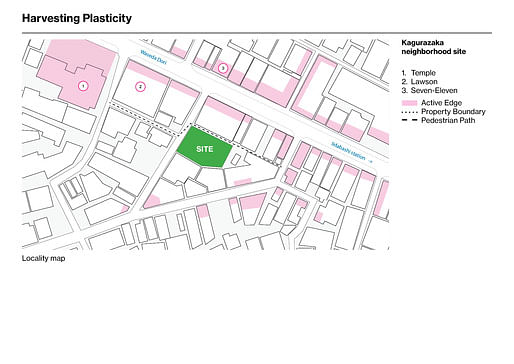 The site is located near Waseda-dori, down a small street. The block contains small restaurants and shops.
The site is located near Waseda-dori, down a small street. The block contains small restaurants and shops.

The proposal is a “harvesting market.” Essentially, it is a farmer’s market run by the convenience store, augmenting the existing network of stores with new ways of acquiring fresh produce.
The proposal consists of four harvesting sheds, where residents who want to re-engage with nature without leaving the comfort of the city can harvest and purchase fresh food.

The proposal also includes a check-out counter and spaces for eating and socializing.
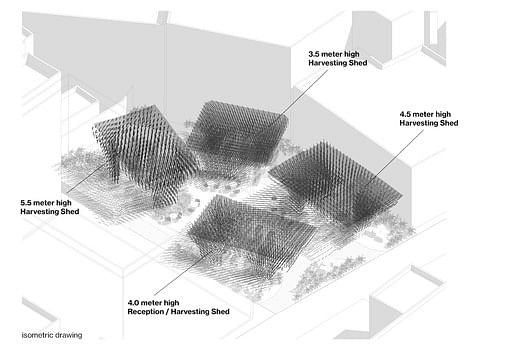
The architectural system is adapted to the site to create harvesting sheds with different heights and spaces.

The sheds contain an average of 2,500 components per pod and 12,563 extruded connections between them. Each pod weighs 158.4 kg. The total proposal requires 633.6 kg of thermoplastic.
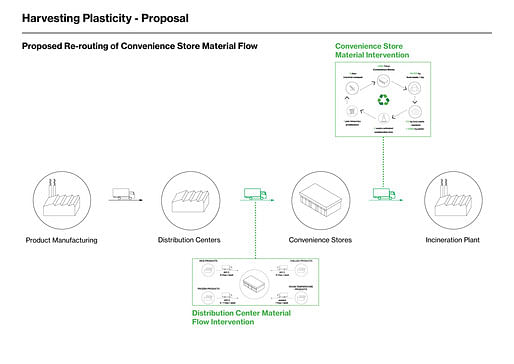
To provide the material for this proposal, it is possible to take advantage of the current material flow of food within the culture of convenience at two critical junctions in the convenience store supply chain.
Right now, food moves from production centers to distribution centers within the city of Tokyo. From here, this food moves out to convenience stores several times everyday. Food that is not purchased generally goes to the incineration plant.
We can intervene within this current process at two critical points.
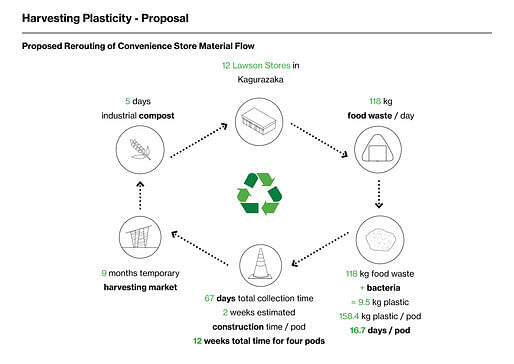
Unsold food can be used to produce the architecture.
Food waste from the twelve Lawson stores within 1 kilometer of the site can be re-routed to make the architecture. This food can be combined with bacteria to produce thermoplastic.
In about 17 days, these stores produce enough material to make one shed. In 67 days, enough plastic can be produced to build the whole proposal. We currently estimate a time of three months to gather the material and build the architecture.

The project can be built in the winter months, the least desirable time to utilize outdoor space. The other nine months can be used to provide seasonal produce to Tokyo-ites. After one year, the architecture can be industrially composted in five days.
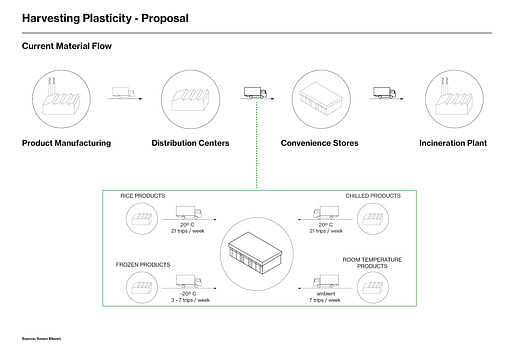
The produce can be replenished within the current convenience store produce supply-chain, which distributes food several times daily to the network. In addition, local food can be grown as well.
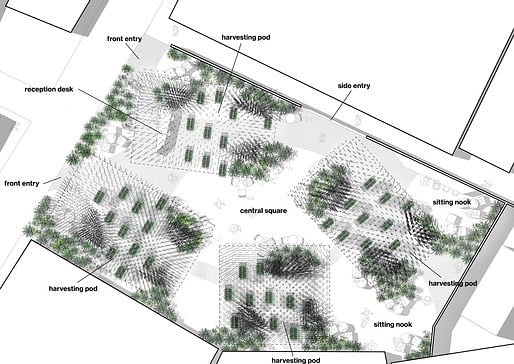
The architectural system is adapted to the site. Spaces within the system are carved out to make way for the produce.
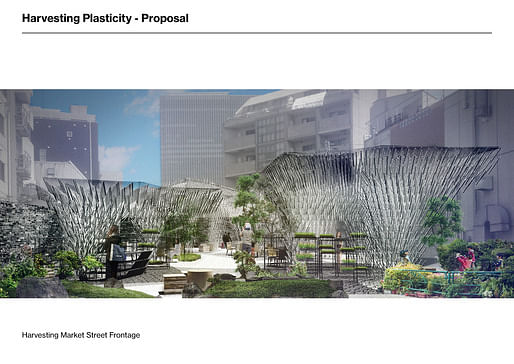
The lightweight, adaptable system allows for shelter from the elements and visual screening.
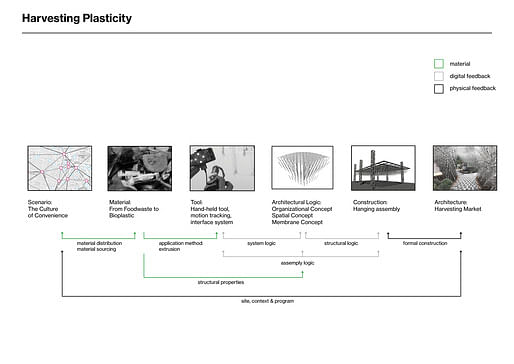
After putting together this proposal, our individual research focused on how to actually fabricate the project. There are four areas of research that were looked at: material, assembly and fabrication, architectural and structural logic, and construction processes.
A student blog dedicated to ongoing happenings in and outside the Advanced Design Studies Program at the University of Tokyo.


No Comments
Block this user
Are you sure you want to block this user and hide all related comments throughout the site?
Archinect
This is your first comment on Archinect. Your comment will be visible once approved.